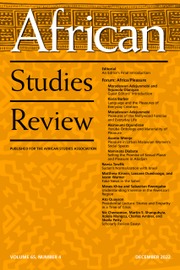Part of review forum on “A dam for Africa”
The conventional wisdom about large-scale dam projects in Africa casts technocrats and elite state officials as the primary drivers of modernization projects, and attributes local communities with little power to halt the inexorable march of infrastructural modernity. A Dam for Africa provides a powerful intervention into this narrative by establishing how Ghana’s largest hydroelectric dam project was forged in the friction-filled interactions between competing groups and shaped by multiple knowledge regimes. Stephan Miescher offers a magisterial and exhaustive biography of the Akosombo Dam project in late colonial and postcolonial Ghana, showing how the dam exceeded state forms of seeing and ordering nature to take on a life of its own. Through meticulous chronicling of Akosombo’s unfolding, Miescher illustrates how material technologies, technopolitical processes, postcolonial ambitions, popular culture, and the river itself interacted to produce new physical and imagined spaces of the nation. Envisaged by Kwame Nkrumah, Akosombo’s comprehensive plan entailed damming the river, generating power which would be channeled into households, illuminating the nation, and fully integrating the aluminum industry. Despite nationalist leaders’ enthusiasm for Akosombo as a pathway to economic liberation and self-fashioned modernity, the dam project was contested politically and became a site of mediation for Nkrumah’s broader engagements with the capitalist West and communist Eastern bloc amidst his policy of nonalignment.
A Dam for Africa is an expansive atlas of the technological things that animated the Ghanaian society in the 1950s to 1980s—from the private jet for which Nkrumah longed, and the television sets that marked privileged status among the Volta Aluminium Company (VALCO) workers, to the charcoal that continues to fuel chop-bar operators when the grid fails them. Miescher’s book brilliantly exposes how a large-scale technological system is not only an assemblage of different interested parties, knowledge practices, and material objects, but also how it has been a living infrastructure, brought to life and near-death through the choreographies of everyday and spectacular encounters. Performed for various publics in mobile film exhibitions, early techno-optimistic dreams give way to the devastating disappointment in the face of capitalist-driven extractive economic forces and technological inertia. In government negotiations with Kaiser Aluminum and Chemical Corporation, for instance, locally mined bauxite was foregone for cheap alumina imported from Jamaica, and later the goal of universally available electricity was subordinated to provision for Kaiser’s smelter. In tandem with the US government, the Kaiser Corporation sought to expand their ambit of influence through the VALCO smelter, while local communities galvanized themselves around the state’s truncated promises to demand access to the “light of the nation.” Stripped-away promises and regrettable shortfalls of the Akosombo dam brought a dizzying kaleidoscope of new plans, policies, and proposals to manage failures and leverage the possibilities that remained.
The book is a crucial contribution to African histories of technology—a field that, despite important attention to technological artifacts like roads and transport, metallurgy, and guns—has only recently seen growing scholarship on hydroelectric dam systems and few studies that stretch across colonial and postcolonial eras. In Akosombo stories, we learn of a different story of technological unfolding in Africa than other dam cases on the continent—one where hydropower development was initially driven by Pan-Africanist aspirations for self-sufficiency, rather than the familiar story of hydropower made by and for colonial governments, often for the pursuit of mineral exploitation. Still, Akosombo was imaginable because of the presence of bauxite at Awaso and the promise of extractive mineral industries, and constrained by neocolonial corporate diplomacy and broader capitalist forces. This is a cautionary tale about the perils of large-scale development projects in the hands of public-private partnerships, where environmental considerations and the equitable provision of services are at the whims of capitalist investors, international development institutions, and aspiring leaders.
As with many excellent books that unpack complex historical processes, A Dam for Africa raises potentially interesting questions that remain answered. One concerns the multiple temporalities at play in the making and (re)making of Akosombo Dam and the embrace of electricity. Miescher shows how Akosombo project interrupted linear trajectories of modernity, for instance, in the case of the resettlement town Amate where residents experienced electrification as “reverse modernization” (221). How did electrification shift people’s relationships with time across colonial and postcolonial eras, if at all? And what of the geological temporalities, the centuries and millennia of rock formation with which state authorities, engineers, and rock-hewers had to contend? How did they reckon with the material properties of the hardened stone masses that slowed their efforts and the chronologies of the dam project? What kinds of distinctive temporalities were bound up with the multiple materials comprising Akosombo Dam, with their different life cycles and paces of decay? Finally, to what extent does this history suggest the existence of what we might call an “age of infrastructure,” an era now marked by aging systems, mounting repair regimes, and new calls for environmental restoration?
No single book can follow every line of inquiry, and these questions signal the very generative way A Dam for Africa opens new pathways for future scholarship on modernization schemes and technology. Beyond African studies, Miescher’s vigorous study reaches across cultural, political, economic, gender, and history of science and technology and will be of wide interest across these subdisciplines. Few have done as well with sustaining deep engagement and sharp analytical focus, and the book born of this intensive labor is an exemplar of sensitive, masterful treatment of people’s lived experiences of infrastructure.


